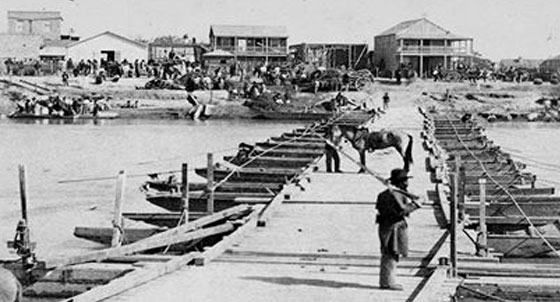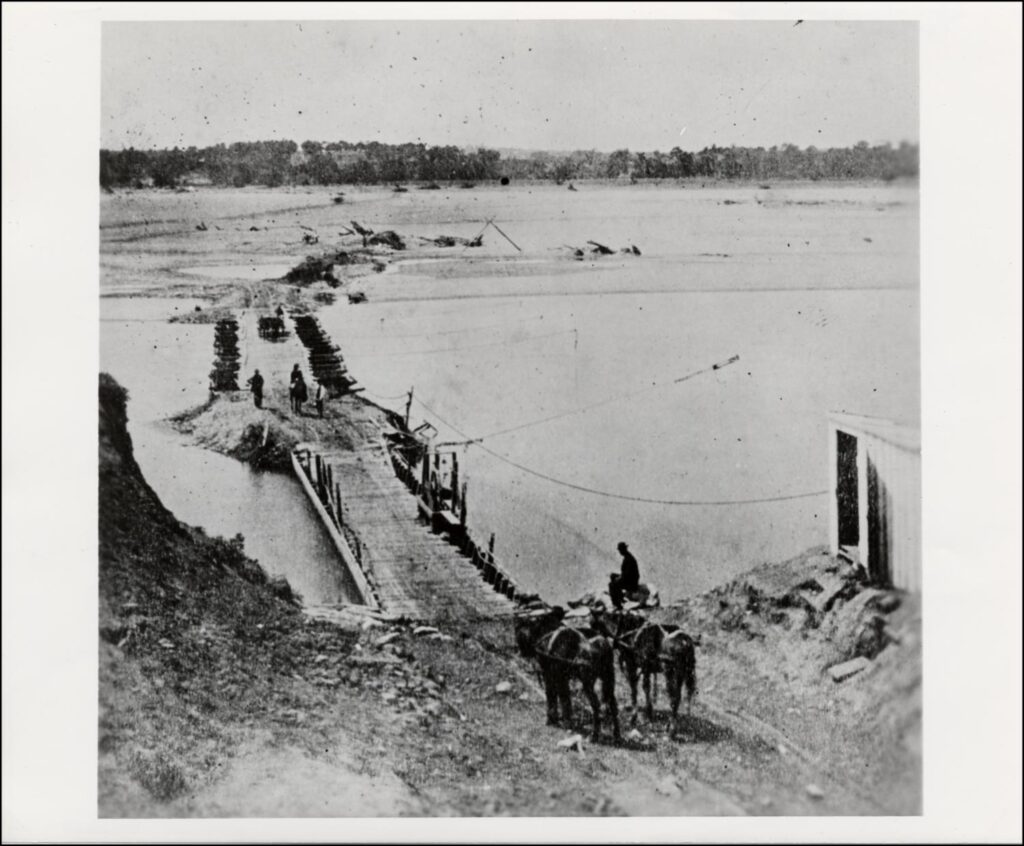Pontoon Bridges in Texas
by Melinda Luna PE | History & Heritage Committee Chair
January 2023

Brownsville and Matamoros c.1866 –
Print courtesy Institute of Texas Cultures,
University of Texas at Brownsville, 73-833.
Pontoon bridges were among the first type of bridges used in Texas to provide more all-weather crossings. One of these early bridges was built by General Zachary Taylor in 1846. He needed a way to transport military supplies of ships onto the mainland. Pontoon bridge construction was taught in military training. The design involves an understanding of Archimedes’ principle. The mass of the water displaced must equal the load of what the pontoon is supporting. The approach to the bridge should not be too steep; the bank must not have erosion or, in the case of tidal areas, must provide for the movement of the tides. There would be other bridges in this area of the same type during the Civil War. In 1936, a Texas Historical Commission Marker on the Palmetto pilings was established where the railroad crossing piling that led to this pontoon bridge was recognized. The cypress pilings can still be seen today.

Not all pontoon bridges built in Texas were for military purposes. A bridge crossing required the approval of the Texas legislature. The pontoon owners would provide a hub for travelers and charge a toll according to what was crossing, whether a wagon or horse. The cost varied from 25 cents to two dollars for a wagon crossing with four horses. A crossing in Austin at the foot of Bowie Street provided a pontoon bridge over the Colorado River in September 1869. This pontoon bridge only lasted until June 1870. Several more versions of the pontoon bridge existed at this location. The pontoon bridge was put in place again and washed out in November of 1871
Some other pontoons existed in Swisher’s crossing, Dewitt County crossing the Guadalupe River, Pecos River crossing near Pecos, and several pontoons along the Rio Grande River.
A few pontoon bridges were put in place to maintain access to the military, such as Camp Melvin in Crockett county over the Pecos River. The pontoon bridge was maintained for some time without too many floods during the time the bridge existed. The Camp was operated as a temporary outpost to handle Indian attacks and, as time passed, a stopping point for travelers going from San Antonio to El Paso. The site was eventually known as Pontoon Crossing.

Click on the photo to view it larger.
With the more attainable crossings like Trusses and concrete bridges, the pontoon bridge construction was not used. However, as a means of temporary crossing, pontoons were utilized. In the floods of early September 1921, a temporary pontoon bridge was used across the Rio Grande to provide a crossing until the bridge was repaired. A pontoon bridge would be put to use in the same area after the flood of 1954 after a significant flood damaged the international bridge. Pontoon bridges were able to be built easier and provided a more reliable crossing than a ferry and fords. Pontoon bridges have existed since the Zhou Dynasty in the 11th century BC. In emergencies, the engineer could leverage this type of construction to provide a crossing. While strong winds and floods could destroy these floating bridges, they provided a way for early pioneers to cross many streams and rivers in Texas and provide for the movement of the military. Although not widely used today, it is still used in military capacities.

Photographic resources from University of North Texas Libraries, The Portal to Texas History, https://texashistory.unt.edu; crediting Austin History Center, Austin Public Library.


